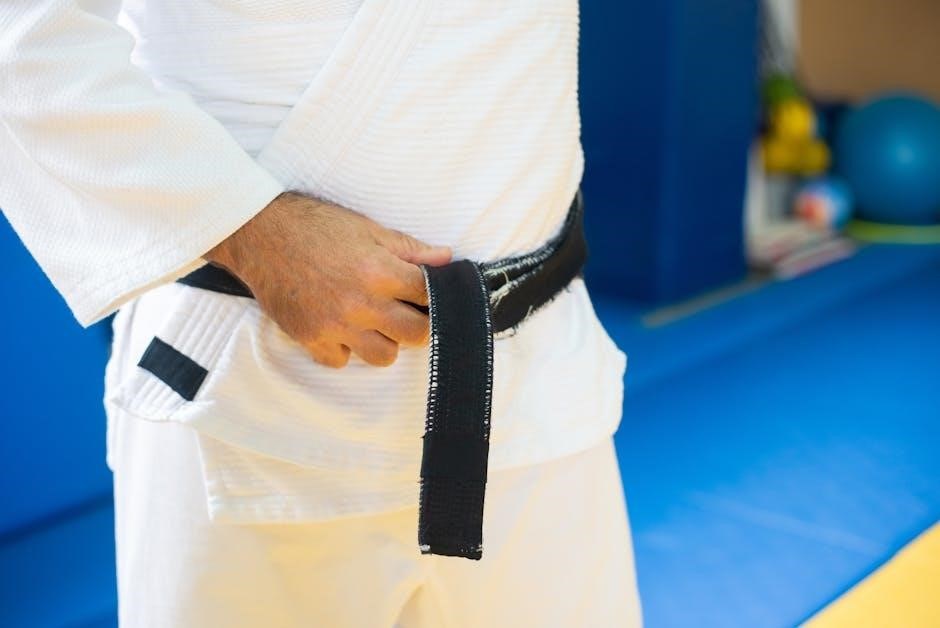jiu jitsu gi size guide
Choosing the right BJJ gi size is crucial for optimal performance and comfort. This guide offers expert advice to help you find the perfect fit, tailored for men, women, and kids, ensuring your gi meets IBJJF standards and enhances your training experience;
Understanding the Importance of Proper Fit in BJJ
A proper-fitting BJJ gi is essential for both performance and comfort. A gi that is too tight restricts movement, while one that is too loose can be easily gripped by opponents, compromising technique. Ensuring your gi meets IBJJF standards guarantees legality in competitions and training. Proper fit enhances mobility, allowing practitioners to execute techniques effectively and train confidently. Whether you’re a beginner or an experienced athlete, the right fit ensures optimal performance, safety, and compliance with regulations, making it a cornerstone of your BJJ journey.
Overview of BJJ Gi Size Charts
BJJ gi size charts are detailed guides that help practitioners choose the right gi based on height, weight, and body type. They typically categorize sizes from A0 to A5 or similar, ensuring a tailored fit for everyone. These charts often include weight ranges and sleeve and pant length measurements to guarantee comfort and mobility. Whether you’re training or competing, using a size chart helps you find a gi that meets IBJJF standards and suits your needs. This ensures your gi is both functional and regulation-compliant, enhancing your overall BJJ experience.
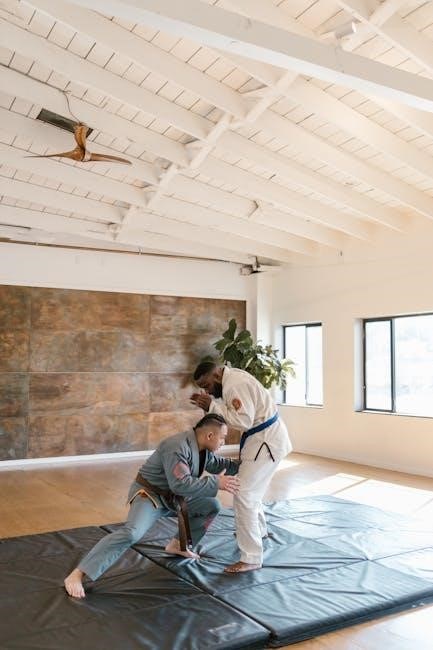
Key Factors in Choosing the Right BJJ Gi Size
Height, weight, body type, and competition requirements are key factors in selecting the right BJJ gi size. Proper fit ensures mobility and compliance with IBJJF standards.
Height and Weight Considerations
Height and weight are fundamental in determining the ideal BJJ gi size. A taller practitioner may require a longer jacket and pants, while weight influences the gi’s fit and durability. Proper sizing ensures comfort and mobility, with charts typically categorizing sizes from A0 to A6 based on these metrics. It’s crucial to balance both factors to avoid a gi that’s too tight or too loose, ensuring optimal performance during training or competition. Always refer to the IBJJF standards to guarantee compliance and a competitive edge.
Body Type and Gi Fit
Body type significantly impacts BJJ gi fit, as different builds require tailored sizing for comfort and mobility. Lean, muscular, or stocky practitioners may need adjustments in sleeve and pant lengths. Slim individuals might prefer a more fitted gi to prevent excess material, while broader builds benefit from a slightly roomier cut. Ensuring the gi fits snugly around the torso and shoulders is essential, as it prevents opponents from gripping excessively. Brands often cater to various body types, so selecting the right one can enhance performance and training efficiency, making it a key consideration in choosing the perfect gi.
Competition vs. Training Gi Requirements
Competition and training gis have distinct requirements to meet different needs. Competition gis must adhere to strict IBJJF standards, including weight categories, sleeve and pant length, and material thickness. They are designed for optimal performance under tournament conditions. Training gis prioritize comfort and durability, offering more flexibility in fit and material choice. While competition gis require precise sizing to avoid disqualification, training gis allow for a balance of mobility and comfort, catering to individual preferences. Understanding these differences ensures you select the right gi for your specific needs, whether you’re training or competing.
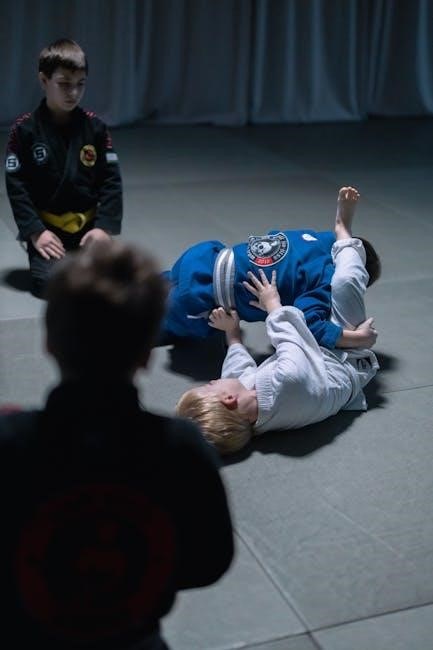
BJJ Gi Size Charts
BJJ Gi Size Charts provide organized sizing by gender and age, covering height, weight, and sleeve length. They offer a starting point for gi selection, ensuring proper fit. However, precise measurements are recommended, as variations exist between brands.
Men’s BJJ Gi Size Chart
Men’s BJJ Gi Size Charts typically range from A0 to A6, correlating to height, weight, and inseam measurements. A0 suits shorter, lighter practitioners, while A6 accommodates taller, heavier athletes. Each size ensures proper fit for rolling and training, balancing comfort and mobility. Personal measurements are crucial, as charts may vary slightly by brand. Always check specific brand guidelines, as some offer slim or husky fits. Proper sizing ensures compliance with competition standards and optimal performance during training, making it easier to focus on technique and movement.
Women’s BJJ Gi Size Chart
Women’s BJJ Gi Size Charts typically range from F1 to F5, designed to fit various body types while ensuring comfort and mobility. Sizes correspond to height, weight, and inseam measurements, with F1 for shorter, lighter practitioners and F5 for taller, heavier athletes. Proper fit is essential for training and competition, balancing snugness and flexibility. Sleeve and pant lengths should align with IBJJF standards, avoiding excessive fabric that could hinder movement. Always consult brand-specific charts, as sizing may vary slightly. Accurate sizing ensures optimal performance and compliance with regulations, allowing focus on technique and training effectiveness.
Children’s BJJ Gi Size Chart
Children’s BJJ Gi Size Charts cater to younger practitioners, typically ranging from ages 2 to 12. Sizes are often labeled as M0 to M5, correlating with height, weight, and inseam measurements. Proper fit ensures comfort and mobility, crucial for developing techniques. Sleeves and pants should not be overly long to avoid interference. Parents should measure accurately, considering growth spurts, and consult brand-specific charts, as sizing may differ. A well-fitted Gi enhances training efficiency and safety, allowing children to focus on skill development and enjoyment of the sport while adhering to academy or competition standards.
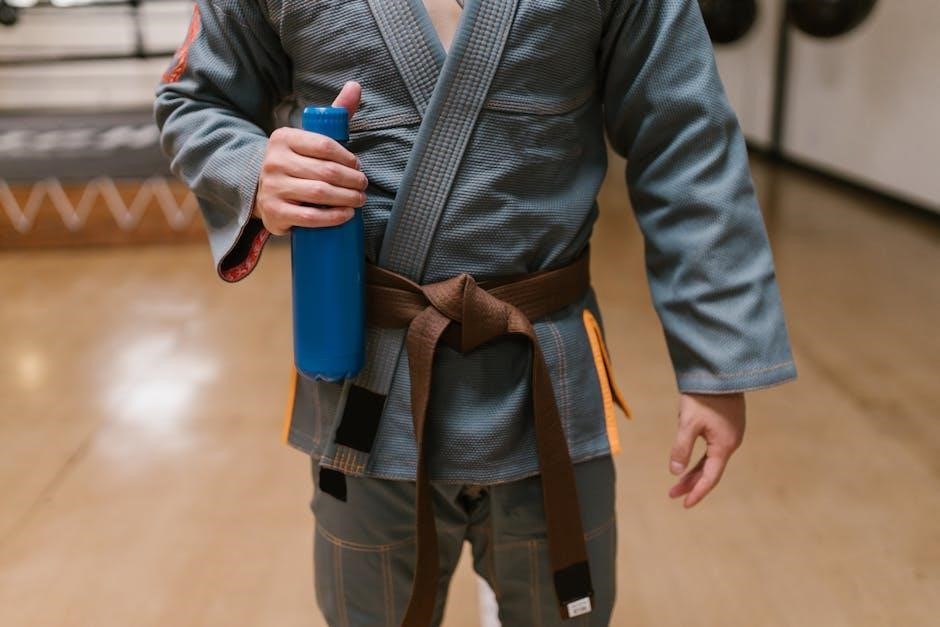
How to Measure for Your BJJ Gi
- Measure chest circumference at the widest point.
- Measure natural waistline, keeping the tape snug.
- Measure sleeve length from shoulder to wrist.
- Measure inseam from crotch to ankle bone.
Step-by-Step Measurement Guide
To ensure the perfect fit, follow these steps:
- Measure your chest: Wrap a tape measure around the widest part of your chest, keeping it level and snug.
- Measure your waist: Place the tape measure at your natural waistline, ensuring it’s snug but not tight.
- Measure sleeve length: Start at the center back of your neck, go over the shoulder, and down to the wrist.
- Measure pant inseam: Measure from the crotch seam to the bottom of the ankle.
- Double-check all measurements to avoid errors.
Accurate measurements ensure a gi that fits well, allowing optimal movement and comfort during training or competition.
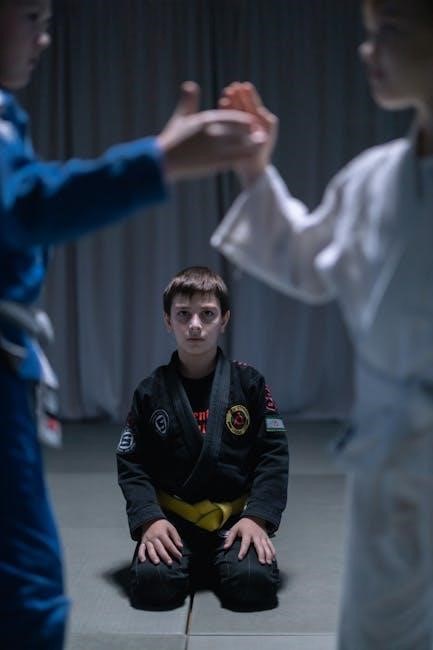
Common Measurement Mistakes to Avoid
When measuring for a BJJ gi, it’s crucial to avoid common errors for the best fit:
- Not keeping the tape measure level, leading to uneven measurements.
- Measuring over thick clothing, which can add unwanted inches.
- Neglecting to measure both chest and waist for accurate sizing.
- Not rechecking measurements, potentially missing errors.
By avoiding these mistakes, you can ensure your gi fits comfortably and performs well during training or competition.
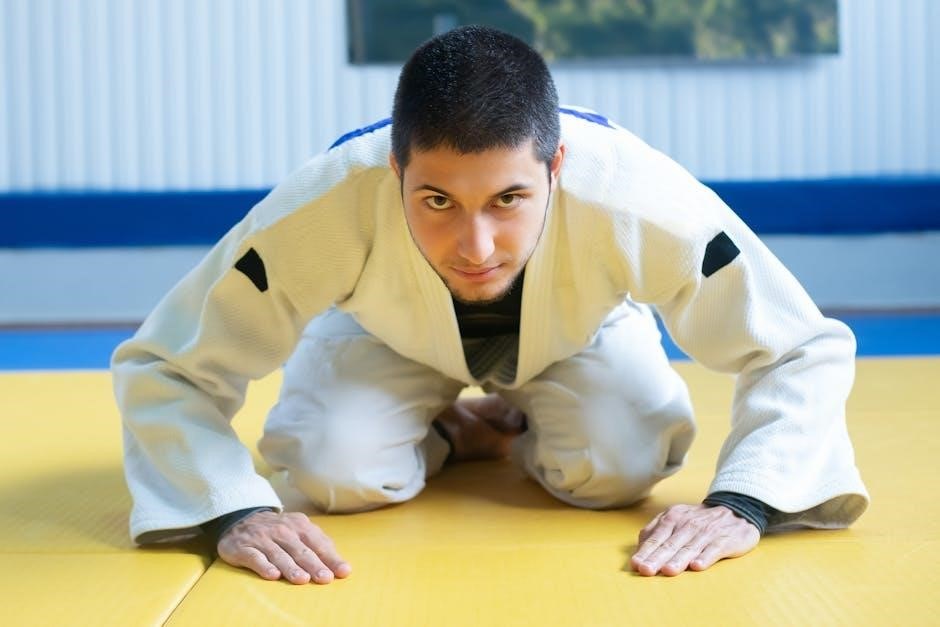
Understanding Gi Weight Categories
BJJ gis come in lightweight, medium, and heavyweight options, catering to different training needs, preferences, and competition regulations, ensuring optimal performance and comfort.
Lightweight, Medium, and Heavyweight Gis
Lightweight gis are ideal for warm weather and athletes prioritizing mobility, often weighing between 400-500gsm. Medium-weight gis (500-550gsm) strike a balance between durability and comfort, making them versatile for daily training. Heavyweight gis (550+gsm) are sturdier, often used in colder climates or by those who prefer a more traditional feel. Each weight category serves distinct purposes, and the choice depends on personal preference, training conditions, and competition requirements. Proper weight selection ensures optimal performance and comfort during rolls and matches.
Choosing the Right Weight for Your Needs
Selecting the ideal gi weight involves considering your training environment, personal comfort, and competition requirements. Lightweight gis are perfect for hot weather and those who prioritize mobility. Medium-weight gis offer a balance of durability and comfort, making them suitable for most training scenarios. Heavyweight gis are ideal for cooler climates and athletes who prefer a more robust feel. Ultimately, your choice should align with your training frequency, climate, and competition standards, ensuring a balance between performance, comfort, and longevity of the gi.
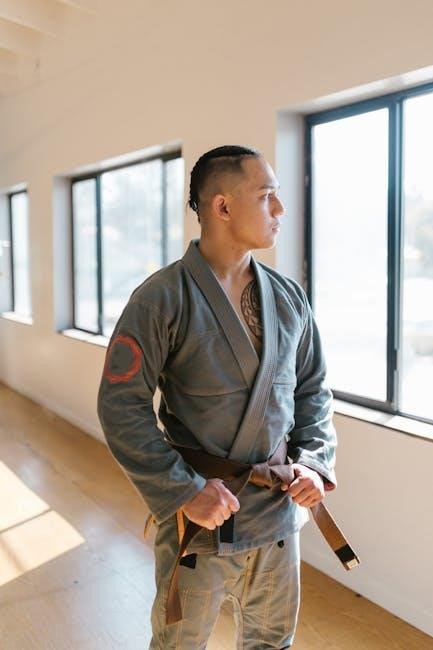
Fit and Comfort
A proper fit enhances performance and comfort, allowing optimal mobility during training. A well-fitted gi ensures confidence and focus on technique, not discomfort.
Priority should be given to a balance between snugness and freedom of movement, ensuring the gi stays in place without restricting your range of motion.
Balancing Snug Fit and Mobility
A snug fit is essential for optimal performance, ensuring the gi stays in place during rolls and transitions. However, it shouldn’t restrict movement, as this can hinder technique execution and comfort. A well-fitted gi allows for a full range of motion, enabling smooth transitions between positions. If the gi is too tight, it can limit mobility, while a loose fit may lead to adjustments during training. Striking this balance is crucial for both training and competition, as it directly impacts performance and confidence on the mat. Proper fit ensures you can focus on your technique without distractions.
Importance of Sleeve and Pant Length
Proper sleeve and pant length are critical for both functionality and regulation compliance. Sleeves should extend to the wrist bone when arms are relaxed, preventing excessive material that opponents could grip. Pants should reach the midpoint of the shin, ensuring coverage while allowing freedom of movement. Incorrect lengths can lead to discomfort, exposure of skin during rolls, or disqualification in competitions. A well-fitted gi ensures optimal performance, as it stays in place during training and competitions, allowing you to focus on technique without distractions. Proper fit in these areas enhances training comfort and compliance with BJJ standards.
Brand-Specific Sizing
Each brand offers unique sizing tailored to body types and training needs, ensuring a personalized fit for optimal performance and comfort on the mat.
Popular BJJ Gi Brands and Their Sizing
Top BJJ gi brands like Gracie, Fuji, Tatami, and Gameness offer sizing that varies slightly, catering to different body types and training preferences. Gracie Gis are known for a slim, athletic fit, while Fuji offers a more standard cut. Tatami Gis often feature a modern, tapered design, and Gameness provides durable, competition-ready options. Each brand tailors its sizing to specific needs, such as lightweight or heavyweight categories. Understanding these differences is key to selecting a gi that aligns with your training style and body type. Always check the brand’s size chart before purchasing to ensure the best fit.
How Brand Sizing Can Vary
BJJ gi sizing can differ significantly between brands due to varying measurement standards and target audiences. Some brands cater to slim, athletic builds, while others accommodate broader or taller frames. Certain brands prioritize durability, offering heavier, sturdier gis, while others focus on lightweight designs for competition. Inseam lengths, sleeve proportions, and collar widths also vary, impacting fit. Weight categories may overlap differently across brands, and some may offer more tailored cuts for specific body types. Always consult the brand’s size chart and reviews to understand how their sizing aligns with your body type and training needs.
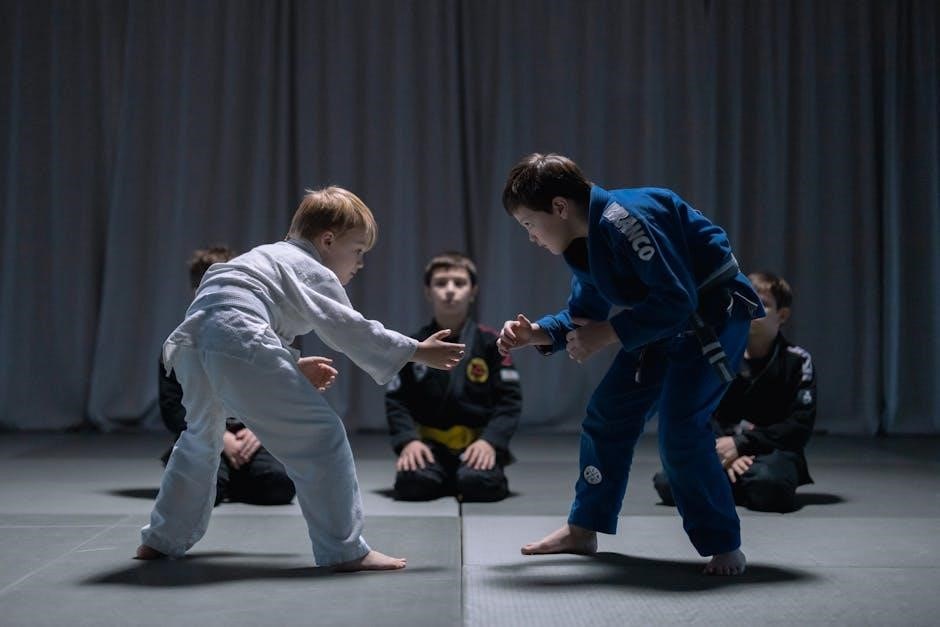
IBJJF Standards for Gi Sizing
The IBJJF sets strict gi sizing standards for competitions, ensuring fair play and safety. Gis must meet specific material, weight, and measurement requirements to be competition-approved.
Competition-Ready Gi Requirements
For a gi to be competition-ready, it must meet IBJJF standards, including material thickness, sleeve and pant length, and weight category. The gi must be made from pre-shrunk cotton or cotton-poly blend, with sleeves reaching the wrist and pants covering the shin. Weight categories ensure fairness, with gis classified as lightweight, medium, or heavyweight. All gis must have the IBJJF logo or be from an approved brand. Proper fit, no excess material, and compliant colors are also mandated. Always check the IBJJF guidelines before competition to ensure your gi meets all requirements for approval.
Ensuring Your Gi Meets Regulations
To ensure your gi meets regulations, always check the size chart and weight category before purchasing. Measure yourself accurately, paying attention to sleeve and pant lengths. Verify that the gi complies with IBJJF standards, including material thickness and color requirements. Double-check the weight category to match your competition class. If unsure, consult with a coach or experienced practitioner. Proper fit and adherence to guidelines are crucial for approval during weigh-ins. Ensuring compliance avoids disqualification and guarantees a smooth competition experience.
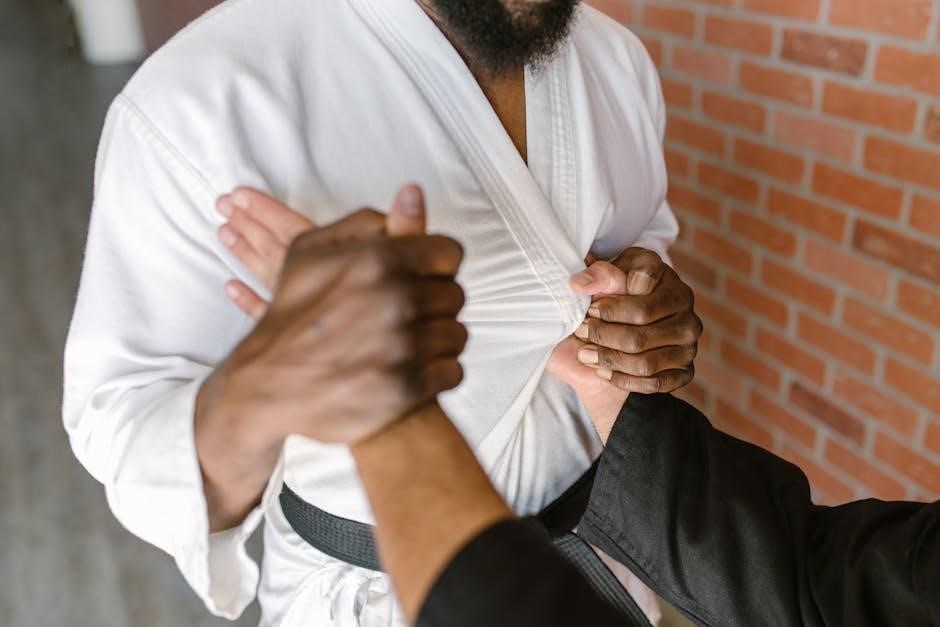
Tips for First-Time Buyers
Focus on comfort, durability, and proper fit. Consider your training frequency and whether it’s for competition or casual use. Seek recommendations and check reviews.
What to Look for in Your First Gi
When selecting your first BJJ gi, prioritize material quality, weave type, and size. Opt for a durable, breathable fabric like cotton or a cotton-poly blend. Consider the weave—lighter weaves are ideal for training, while heavier ones are more durable. Ensure proper fit by consulting size charts and reading reviews. Look for reinforced stitching and a comfortable collar. Avoid overly flashy designs unless they align with your personal style. Lastly, ensure the gi meets IBJJF standards if you plan to compete. A well-chosen gi enhances comfort and performance, making your training experience more enjoyable and effective.
Common Mistakes to Avoid
When buying your first BJJ gi, avoid common pitfalls like guessing your size instead of measuring. Overlooking material quality can lead to discomfort or premature wear. Don’t prioritize aesthetics over functionality—opt for durability and fit. Ignoring IBJJF regulations may result in disqualification during competitions. Avoid tight fits that restrict movement and overly loose gis that bunch up. Lastly, don’t skip reading reviews or consulting size charts, as this can lead to poor fit. By avoiding these mistakes, you’ll ensure a comfortable, functional, and competition-ready gi that enhances your training experience and confidence on the mat.
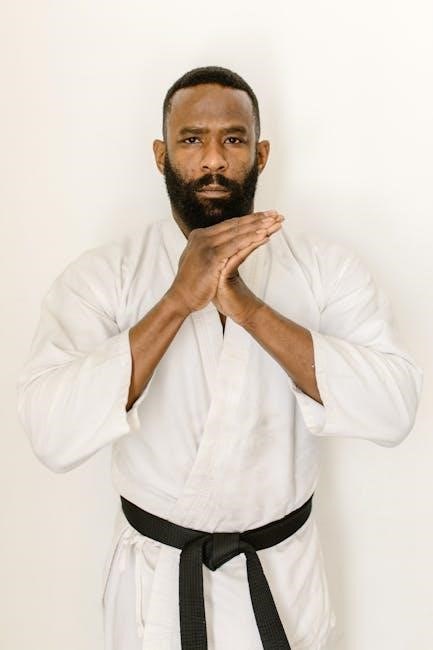
Maintenance and Care
Wash your BJJ gi in cold water using mild detergent. Avoid bleach and fabric softeners to preserve the material. Air dry to prevent shrinkage and maintain quality.
Caring for Your Gi to Ensure Longevity
Proper care extends your BJJ gi’s life. After training, hang it to air dry, avoiding damp environments. Wash in cold water with mild detergent, avoiding bleach. Air dry or tumble dry on low. Store neatly to prevent creases. Clean regularly to prevent odor buildup without over-washing. Check care labels for specific instructions. Proper storage and gentle washing maintain fabric integrity and longevity.
How to Prevent Shrinkage and Color Fade
To maintain your BJJ gi’s quality, wash it in cold water using mild detergent. Avoid bleach or harsh chemicals, as they can cause color fade. Turn the gi inside out before washing to protect the design. Air dry it instead of using a dryer, as heat can shrink the fabric. Iron on low heat if necessary, avoiding patches or embroidered areas. Store it in a cool, dry place to prevent fading. Regular care ensures your gi remains vibrant and well-fitting for years of training.
Choosing the right BJJ gi is a journey of fit, comfort, and confidence. Train with passion, knowing proper sizing enhances performance and longevity.
Final Thoughts on Choosing the Right Gi Size
Choosing the right BJJ gi size is essential for optimal performance and comfort. Proper fit ensures better mobility, durability, and confidence during training or competition. Always consider your height, weight, and body type when selecting a gi. Remember, a well-fitted gi not only enhances your technique but also boosts your overall training experience. By following size guides and understanding your needs, you can make an informed decision. Train comfortably, compete confidently, and embrace the journey of mastering Brazilian Jiu-Jitsu with the right gear by your side.
Encouragement to Train Comfortably and Confidently
Training in BJJ is a journey of growth and self-improvement. A properly fitted gi is more than just gear—it’s a foundation for confidence and comfort. When you feel good in your gi, you can focus on technique, movement, and progression. Remember, consistency is key, and every roll is a step forward. Embrace the process, train with passion, and let your gi be a trusted companion on your martial arts path. With the right fit, you’ll feel empowered to push limits and enjoy the art of Brazilian Jiu-Jitsu to its fullest potential.
